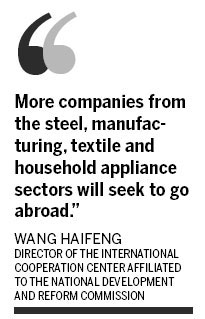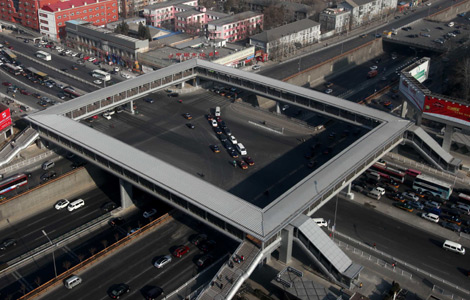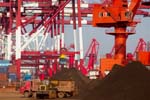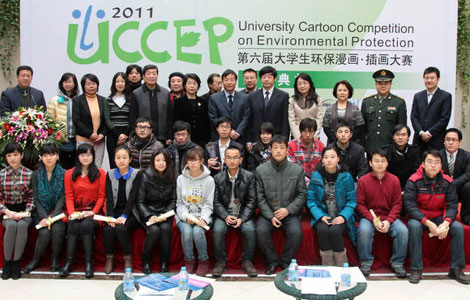Ministry predicts new surge in ODI
Updated: 2012-01-05 07:18
By Ding Qingfen, Li Jiabao and Oswald Chen (China Daily)
|
|||||||||||
Expansion will match foreign direct investment, experts say
BEIJING / HONG KONG - Outbound direct investment (ODI) for 2011-15 is expected to register double-digit annual growth to reach $560 billion, matching the nation's foreign direct investment (FDI), a statement from the Ministry of Commerce said.
The government will accelerate promoting "overseas investment" during the 12th Five-Year Plan (2011-15) period, the statement, posted on the website of the ministry on Wednesday, said.
The scale of accumulative ODI from 2011 to 2015 will reach the level of the nation's FDI, according to the statement.
"The annual growth rate (from 2011 to 2015) for the nation's ODI on average will remain around 17 percent, and the accumulative volume in the five years is expected to reach $560 billion, equivalent to that of China's FDI during the same period," it said.
|
 |
ODI growth has remained robust despite the global financial crisis.
ODI in the non-financial sector, in 2010, surged as high as 36.3 percent year-on-year to $59 billion, after it gained 14.2 percent in 2009. China overtook Japan and the United Kingdom that year to become the world's fifth-largest overseas investing nation.
From January to November of 2011, ODI in the non-financial sector grew by 5.2 percent year-on-year to $50 billion, according to the ministry. By the end of November accumulative investment reached $312 billion.
"The target (of 17 percent) is really positive. There is no doubt that ODI in the next few years will grow rapidly thanks to China holding large volumes of foreign exchange reserves and its huge demand for agriculture and mining products," said Jin Baisong, researcher at the Chinese Academy of International Trade and Economic Cooperation affiliated to the ministry.
In the statement the ministry said the government will guide and encourage local companies to enhance cooperation and invest abroad in manufacturing, energy, culture and engineering.
And China will also promote investment in the service sector, including finance, architecture, tourism, education and telecoms.
ODI will play a more dominant role in the future, said Professor Chong Tai-leung of the Chinese University of Hong Kong's Institute of Global Economics and Finance.
"I predict that ODI, rather than FDI, will be dominant in the future as more mainland firms are taking excess cash outside the country to invest in various economic projects overseas," he said.
"More ODI means that capital is invested outside the country, so that the ODI will not help boost domestic economic growth very much.
"But ODI can help mainland corporations to expand their business footprint through technology and management skills."
Standard Chartered global research head Nicholas Kwan said that both ODI and FDI can help the domestic economy.
"The announcement by the ministry shows that the government is committed to attracting foreign capital into the country as well as promoting mainland companies to invest overseas. The simultaneous growth of FDI and ODI can help the economic transformation of the country."
While the European debt crisis is still unresolved and the US is troubled by high unemployment, Chinese enterprises will find it easier to enter developed markets, experts said.
China Three Gorges Corp recently agreed to pay 2.69 billion euros ($3.5 billion) for a 21 percent stake in EDP-Energias de Portugal, Portugal's biggest utility, to gain access to wind and hydropower assets in Europe and the Americas. It is also the Chinese company's biggest cross-border acquisition.
Corporate Chairman Cao Guangjing said on Wednesday, at a news briefing in Lisbon, that Three Gorges is looking for acquisitions abroad if the price is right.
It's not only about State-owned companies. Executives from the Qingdao Kingking Group, the world's second-largest candle maker, told China Daily on Tuesday that it plans to invest $100 million globally to develop gold and copper mines in the next three years.
"More companies from the steel, manufacturing, textile and household appliance sectors will seek to go abroad," said Wang Haifeng, director of the International Cooperation Center affiliated to the National Development and Reform Commission. "Southeast Asia, Africa and Latin America will be the favored destinations."
FDI growth
The FDI outlook is less promising. From 2011 to 2015, China's annual FDI is expected to reach, on average, $120 billion, with improved quality and diversification, the statement said.
During 11 months of 2011, China's FDI surged by 13 percent year-on-year to $103.8 billion, close to the level of 2010. The figure for the whole year is expected to range from $110 to $120 billion, experts predicted.
"Foreign investment will be important for China, but quality, rather than the scale of investment, will be the priority for the government," said Wang Zhile, director of the ministry's research center for transnational cooperation.
China will encourage foreign enterprises to invest in agriculture, high-end manufacturing, high-tech, new energy and services, the statement said.
In foreign investment guidelines released last Friday, China said it will open more sectors to foreign investors.
According to the ministry's statement, China's commodity trade will enjoy an annual growth of 10 percent from 2011 to 2015, reaching $4.8 trillion in 2015.
Related Stories
China's Jan-Nov ODI reaches $50b 2011-12-16 09:16
Suspicion dampens inflows 2011-12-09 08:10
- Analysts: IPOs to remain common in 2012
- Sinochem to look for oil in deep waters
- Audit finds 'questionable' local govt transactions
- More trade frictions expected in 2012
- New capital rules for banks 'delayed to H2'
- PBOC to regulate RQFII programs
- Foreign trade to top $4.8t in 2015
- Fake peanut oil seized from shelves









